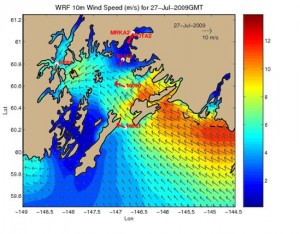It’s 3 a.m. and a fisherman needs to know what the weather will be like for Prince William Sound over the next 48-hour fishing window. Mariners need solid weather forecasts—especially when conditions turn marginal.
The Sound has a dense network of observation platforms, with more than 20 weather stations within an area of 100 square kilometers. Because of this dense network, AOOS Prince William Sound Observing System forecasts can be better scaled for the needs of local mariners. Weather stations provide more surface observations that tell us how well the models are performing, and also provide real-time measurements of actual weather conditions.
Weather Models: WRF
The Alaska Experimental Forecast Facility (AEFF) operates two weather models for PWS. The Weather Research and Forecasting (WRF) system is now being primarily used for the atmospheric modeling in PWS, and is compatible with NWS requirements. Where the NWS now only has forecasts for areas of about 12 km, the models developed by AEFF allow for forecasts of areas as small as 4 km.
The WRF model is systematically run twice per day and produces forecasts for wind, precipitation, snow water equivalent, and other parameters. Wind forecasts are particularly important provide critical input for other regional modeling efforts such as ROMS and SWAN. During the field experiment, real-time data was assimilated and compared with model output.
You can view today’s WRF forecast by visiting the AOOS Model Explorer.


